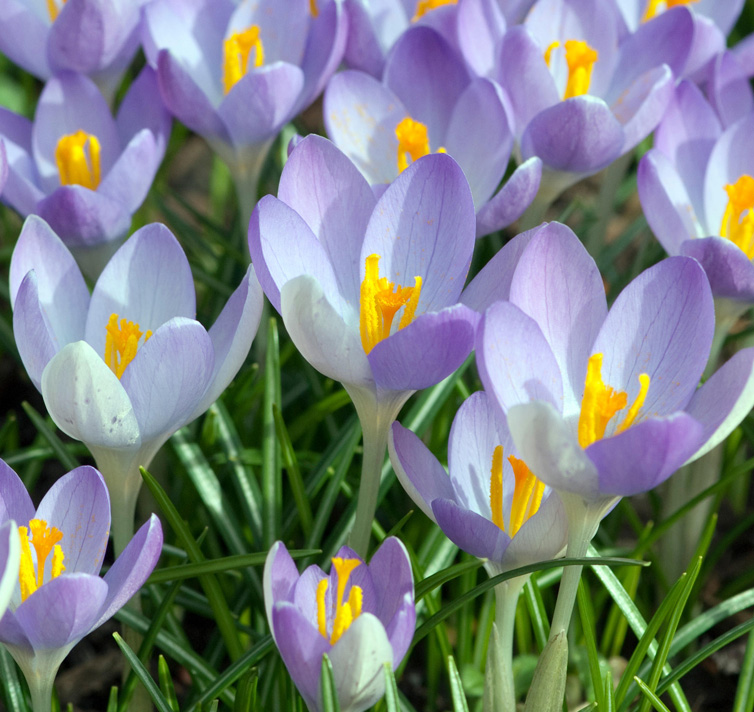- 1-9 pkts $4.50
- 10 pkts FREE
- Express post $12
Crocus tommasinianus
EARLY TOMMIES CROCUS
Crocus tommasinianus is one of the very earliest flowers to herald that spring will be popping soon.
Late winter cheer
Goblet flowers of soft lilac-lavender-mauve (individual flowers usually vary in shade) erupt from the earth in late winter, to cheer us into spring.
Goblet blooms of soft lilac-lavender-mauve
The blooming of the “Early Tommies” lifts the winter gloom, and your spirits, every year.
Petite but big on charm
Large goblet blooms seem to erupt straight from the soil – they only stand 8-10cm. tall.
With the flowers set off by a frame of fine, needle like foliage.
Foliage obligingly dies away neatly by mid-summer. This is a no-mess plant.
Perfect for front edges, pots or under taller deciduous shrubs & trees
So these little beauties are perfect for planting along the front of flower beds, where later perennial or annual flowers will come later.
Or amongst rocks, in pots to cheer winter with colour, or mass planted for early show under deciduous trees and shrubs.
More each year
Because dear little Crocus tommasinianus multiplies each year, to make a dense clump of goblet flowers.
Each bulb delivers multiple blooms each winter, then multiplies by both bulb offsets and seed.
So they make an even more impressive clump of blooms each year.
Flowers are resistant to bad weather
Flowers open in the sun, and then shut up for the night or during gloomy rain.
So they are very resistant to bad wintry weather, and shine on despite it.
Hardy in winter cold & summer heat
Crocus tommasinianus is native to areas of Hungary, Croatia, Bulgaria etc – so it is well adapted to areas with hot, dry summers, and cold winters.
It is a bulbous perennial, so is dormant over the worst of summer.
Frost hardy
Hardy little “Early Tommies” are perfectly used to dealing with cold down to approx. -30°C, so laugh at any frost.
Heat hardy in summer too
“Early Tommies” are also naturally adapted to high summer temperatures, including 40°C.
Water-wise
As they are dormant bulbs over summer – they require only minimal summer water, and are well adapted to summer drought.
Thrive in a wide range of soils
They also thrive in a wide range of soils – from sandy, through garden loam, to clay.
And with a wide range of soil pH – from acid, through neutral to alkaline limestone soils.
Their only demand is that the soil drains well – they will rot in a bog.
Vital early energy for bees & pollinators
Flowers of Crocus tommasinianus are rich in both pollen and nectar, with their stamens proudly on display.
So they provide vital food energy for bees and other insect pollinators, and at an important early stage, during late winter-very early spring.
When there is little else available for their sustenance.
Food for Queen Bees
They are a particularly important food source for Queen Bees as they build up energy to make new hives.
Rabbit & deer resistant
Fortunately Crocus tommasinianus is considered the most rabbit and deer resistant of all the family of Crocus bulbs. While the beasts may take a little nibble on newly emerging foliage if really hungry, they generally prefer to leave Early Tommies well alone.
SEED SOWING ADVICE:
Sow Crocus tommasinianus seeds in the garden in autumn or early winter, and allow the cold of winter to start germination.
OR
Sow at any time indoors in a punnet, whenever suitable temperatures can be provided.
Sow indoors for optimum germination: First sow the seeds in a punnet on the surface of good quality seed raising mix.
Now pat gently into the surface of the mix to ensure the seeds have good contact with the mix.
But cover the seeds only lightly with sieved mix / fine vermiculite.
These seeds need light to germinate.
Then thoroughly moisten the punnet by standing it in a shallow water bath, and allowing the moisture to percolate up to the surface of the mix from below.
Keep the sown punnet or pots in a warm well-lit spot for 2-4 weeks (not in any direct sunlight).
Temperatures of 18-22°C are optimum for this pre-conditioning stage.
Continue to keep the punnet consistently moist by misting from a spray water-bottle.
Covering the punnet with a clear plastic lid or clear plastic bag will also help to maintain consistent moisture.
After the pre-conditioning weeks – then wrap the moist punnet in cling-wrap or plastic bag, and place in the fridge (not freezer) for a further 4-6 weeks of chilling.
Finally remove the punnet from the fridge, unwrap, and return it to a cool, well-lit spot.
Temperatures of 10-15°C are optimum at this stage, for the seeds to germinate.
Some seeds be may quick to appear, and sprout in approx. 30 days, while others may take longer to germinate.
This is a natural process, as the plant cunningly sets up it’s seeds to germinate at staggered intervals. Thus ensuring better survival chances for the babies.
So do not discard the punnet too quickly as more seeds will continue to germinate – patience is rewarded.
Then gently prick out the seedlings as they appear, and pot on to grow good corms before planting out in the garden.
Seed Count: 6 seeds per pack.
(We always aim to exceed the stated seed count and give a generous serve).
Click here for Nursery Open Days & Open Gardens Information
https://www.gardivalia.com.au/open-gardens
Click here to go back to Seeds Shop
https://www.seedscape.net.au/shop/
Related products
-
Add to WishlistAlready In WishlistAdd to Wishlist
-
Add to WishlistAlready In WishlistAdd to Wishlist
-
Add to WishlistAlready In WishlistAdd to Wishlist
-
Add to WishlistAlready In WishlistAdd to Wishlist





